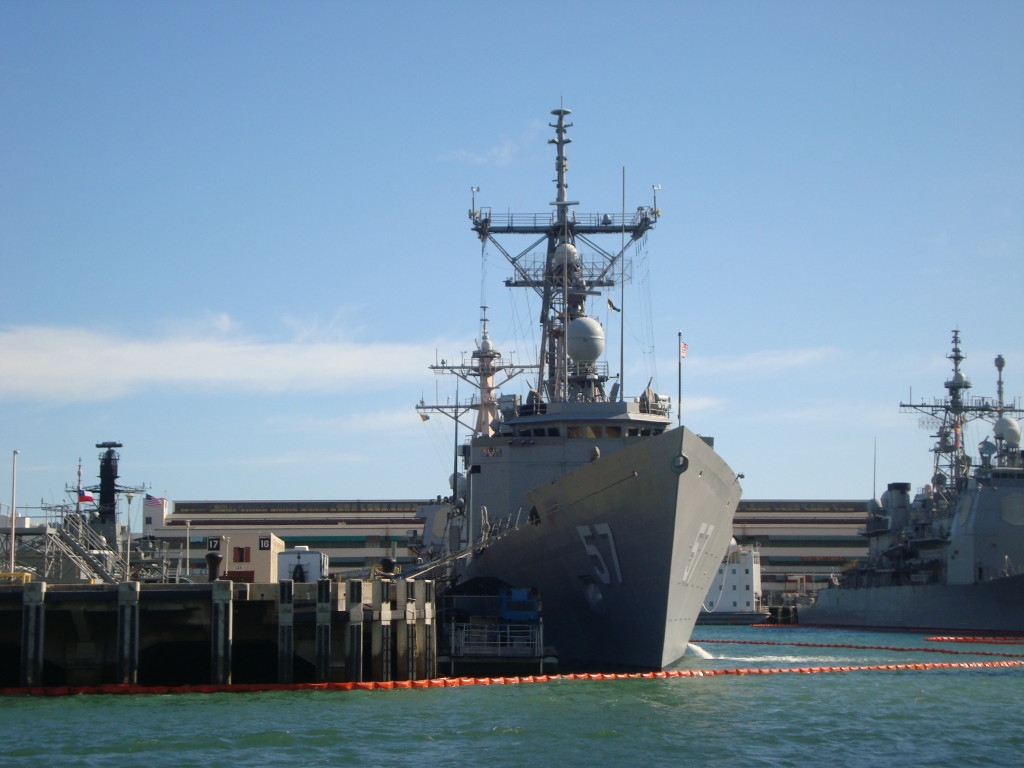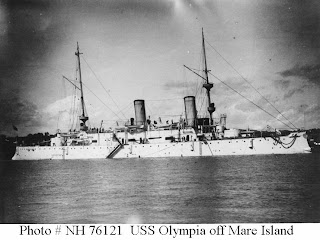It was the end of an era yesterday at Pearl Harbor.
The USS Reuben James, FFG-57, the last frigate based at Pearl Harbor, was decommissioned.
I’m not sure when the last time was that Pearl Harbor was not home to a frigate, and an answer to this question is complicated by the complicated and often contradictory vessel classification schemes that the U.S. navy has employed since World War II. My best guess is that Pearl Harbor was probably home to frigates pretty consistently since the 1960s. (Before the 1960s, the types of vessels that the Navy now refers to as frigates were called destroyer escorts.)
The exact definition of what a “frigate” is differs depending on where in the world you are, but modern frigates were products of the Cold War. They were designed to be submarine hunters and escort ships–they are smaller than their cruiser/destroyer siblings but also cheaper (both in construction and in operating expenses). While ships designated as frigates are still being built throughout the world, the distinction between a “frigate,” “corvette, and “destroyer” is blurring, and the United States has not built any new “frigates” since 1989. In its place, the Navy is building a new type of warships called the littoral combat ship–a ship that is extremely fast and flexible, though it has had more than its share of controversy.
Before moving on, let me just note a few interesting things about the USS Reuben James. Officially, she is a “guided missile frigate,” this is a bit of a misnomer since the fact is that no U.S. Navy frigates have actually been equipped to fire guided missiles for many years, since the primary surface missile the ship was designed to fire has become obsolete.
Second, she is the third ship to bear the name Reuben James. The first was a four-stacked naval destroyer built immediately after World War I. The first USS Reuben James was one of the first casualties of the Second World War–having been sunk by a German submarine in October 1941 with a loss of 115 lives, several months before the two countries officially went to war with each other. The second Reuben James was a destroyer escort built in 1943 and serving throughout World War II. The current Reuben James was commissioned in 1986, and is one of the few ships remaining in the Navy that are older than me. (Hey, this is sad for me–I used to tell people that I would consider myself old as soon as the Navy started retiring ships that were younger than me, something that has already started). All three ships were named after a boatswain’s mate who distinguished himself fighting the Barbary pirates.
The frigate has been one of the backbones of the Navy for decades, and although almost 20 of these ships still remain in service, it appears likely that all ships of this type will be retired before the end of the decade. This isn’t surprising–the ship type is old, outdated, and tired. However, it is sad to see them go. Although much attention in the U.S. Navy goes to its larger, AEGIS equipped sibling destroyers and cruisers (as well as the monstrous aircraft carriers), I have always appreciated the simplicity and brute effectiveness of the smaller frigates.
On a more personal level, I will really miss watching the U.S. Navy’s frigates drive through the waters of Pearl Harbor as they leave and return from deployments. The frigates have a very distinctive hull type that I could identify even from afar. Of course, these ships are beautiful up close too–and I was lucky enough to see the USS Reuben James up close during a RIMPAC boat tour in 2012.
It’ll be interesting to see where this ship will go next. Her sister ship, the USS Crommelin (FFG-37) was moored in the Navy’s Inactive Ship Maintenance Facility in Middle Loch for a while (and she may still be there) while on hold for a possible sale to a foreign navy. A U.S. Navy memo states that the USS Reuben James is also to be held for a possible sale to a foreign navy. Perhaps both ships will see a second life abroad, then (it’s also possible, given their advanced ages, that the ships will become a hulk for spare parts after they are sold, since a number of countries have active Oliver Hazard Perry-class frigates in service that are themselves aging).
Thank you for your service, USS Reuben James. Enjoy your retirement!




